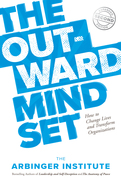Search Results: "Social Venture Networks"
Results 403-404 of 404
The Outward Mindset
2019
The new edition of an international bestseller helps individuals and organizations shift to a new mindset that will improve performance, spark collaboration, accelerate innovation, and make your life and the lives of everyone around you better.
Without even being aware of it, many of us operate from an inward mindset, a single-minded focus on our own goals and objectives. This book points out the many ways, some quite subtle and deceptive, that this mindset invites tension and conflict. But incredible things happen when people switch to an outward mindset. They intuitively understand what coworkers, colleagues, family, and friends need to be successful and happy. Their organizations thrive, and astonishingly, by focusing on others they become happier and more successful themselves! This new mindset brings about deep and far-reaching changes.
The Outward Mindset presents compelling true stories to illustrate the gaps that individuals and organizations typically experience between their actual inward mindsets and their needed outward mindsets. And it provides simple yet profound guidance and tools to help bridge this mindset gap. This new edition includes a new preface, updated case studies, and new material covering Arbinger's latest research on mindsets. In the long run, changing negative behavior without changing one's mindset doesn't last—the old behaviors always reassert themselves. But changing the mindset that causes the behavior changes everything.
Without even being aware of it, many of us operate from an inward mindset, a single-minded focus on our own goals and objectives. This book points out the many ways, some quite subtle and deceptive, that this mindset invites tension and conflict. But incredible things happen when people switch to an outward mindset. They intuitively understand what coworkers, colleagues, family, and friends need to be successful and happy. Their organizations thrive, and astonishingly, by focusing on others they become happier and more successful themselves! This new mindset brings about deep and far-reaching changes.
The Outward Mindset presents compelling true stories to illustrate the gaps that individuals and organizations typically experience between their actual inward mindsets and their needed outward mindsets. And it provides simple yet profound guidance and tools to help bridge this mindset gap. This new edition includes a new preface, updated case studies, and new material covering Arbinger's latest research on mindsets. In the long run, changing negative behavior without changing one's mindset doesn't last—the old behaviors always reassert themselves. But changing the mindset that causes the behavior changes everything.













